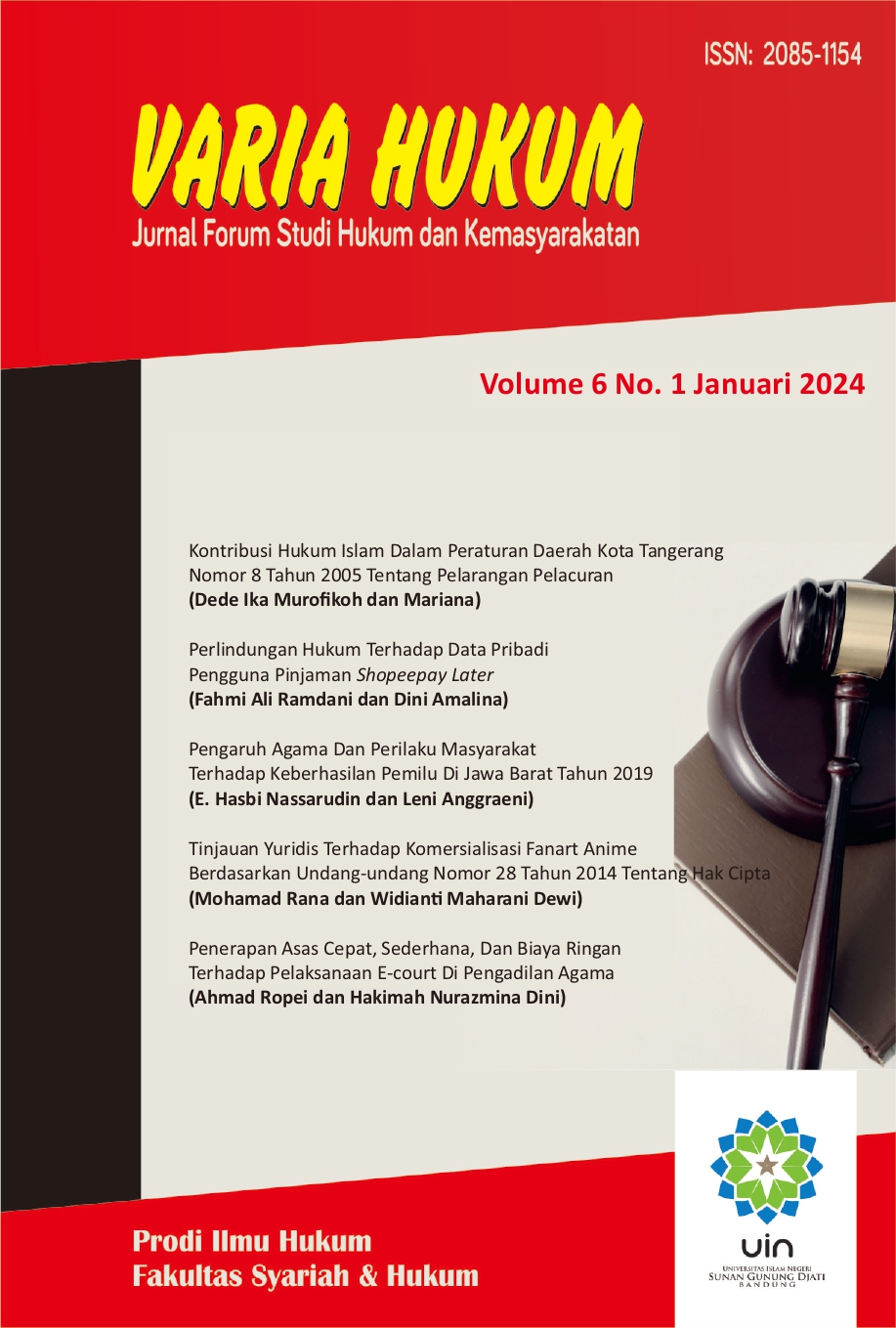PERLINDUNGAN HUKUM DAN TANTANGAN KEBIJAKAN DALAM MENGATASI MUTILASI GENITAL PEREMPUAN TANPA INDIKASI MEDIS
Legal Protection and Policy Challenges in Addressing Female Genital Mutilation without Medical Indication
DOI:
https://doi.org/10.15575/vh.v6i2.44610Abstract
The practice of female genital cutting and injury (P2GP) without medical justification constitutes a violation of human rights and poses a high risk to women's physical and psychological health. Therefore, legal protection is necessary to regulate female genital mutilation (FGM) without medical indications. This study aims to analyze the legal protection for women against the harmful practice of P2GP and to identify challenges in policy implementation. The research methodology adopts a normative approach by analyzing legislation, international human rights instruments, and case studies from several countries that have implemented strict policies against P2GP. Additionally, this study is integrated with an empirical approach through interviews and surveys with affected women and relevant stakeholders. The findings indicate that although various legal instruments are in place, the effectiveness of legal protection still faces obstacles, such as weak law enforcement, cultural factors, and a lack of public awareness. Some countries have imposed strict sanctions on P2GP perpetrators; however, the success of implementation largely depends on social and political support. The study concludes that stronger legal reforms are necessary by clarifying and tightening regulations that prohibit female genital mutilation (FGM) without medical indications, including imposing stricter sanctions on perpetrators and involved parties. Furthermore, increased public education through awareness campaigns highlighting the negative impacts of P2GP on health and human rights is essential to eliminating the practice. The limitations of this study include restricted empirical data from certain regions that are difficult to access due to cultural barriers or limited data availability. The practical implications of this research include policy recommendations to strengthen regulation and law enforcement, while its social implications highlight the need for a paradigm shift in society regarding this deeply rooted practice.
References
Abathun, Asresash Demissie, Johanne Sundby, dan Abdi Ali Gele. "Attitude toward Female Genital Mutilation among Somali and Harari People, Eastern Ethiopia." International Journal of Women’s Health Volume 8 (Oktober 2016): 557–69. https://doi.org/10.2147/IJWH.S112226.
Al Ansori, Nasihudin, dan Ade. "Komnas Perempuan Ungkap Tantangan Cegah Sunat Perempuan, Salah Satunya Karena Ketidaktahuan Masyarakat - Health Liputan6.Com." 2024. https://www.liputan6.com/health/read/5713695/komnas-perempuan-ungkap-tantangan-cegah-sunat-perempuan-salah-satunya-karena-ketidaktahuan-masyarakat?utm_source=chatgpt.com&page=4.
Dawson, Angela, dkk. "Addressing Female Genital Mutilation in the Asia Pacific: The Neglected Sustainable Development Target." Australian and New Zealand Journal of Public Health 44, no. 1 (Februari 2020): 8–10. https://doi.org/10.1111/1753-6405.12956.
Erwanti, Oktavia, dan Elfia Farida Marlinda. "Kajian Yuridis Female Genital Mutilation (FGM) Dalam Perspektif Hak Asasi Manusia (Studi Terhadap Praktik Female Genital Mutilation Di Indonesia)." 2012. http://ejournal-s1.undip.ac.id/index.php/dlr.
Fatimah. "Perlindungan Hak Atas Kesehatan (Right to Health) Terhadap Perempuan Kaitannya Dengan Female Genital Mutilation (FGM) Di Indonesia Article Abstract." JIH Lasadindi 1, no. 2024 (2024).
Hodijah, Siti Nurwati dkk. Persimpangan Antara Tradisi & Modernitas. 2018.
Koski, Alissa, dan Jody Heymann. "Thirty-Year Trends in the Prevalence and Severity of Female Genital Mutilation: A Comparison of 22 Countries." BMJ Global Health 2, no. 4 (November 2017): bmjgh-2017-000467. https://doi.org/10.1136/bmjgh-2017-000467.
Klein, Elliot, dkk. "Female Genital Mutilation: Health Consequences and Complications—A Short Literature Review." Obstetrics and Gynecology International 2018 (10 Juli 2018): 1–7. https://doi.org/10.1155/2018/7365715.
Lurie, Jacob Michael, dkk. "Painful Gynecologic and Obstetric Complications of Female Genital Mutilation/Cutting: A Systematic Review and Meta-Analysis." PLOS Medicine 17, no. 3 (31 Maret 2020): e1003088. https://doi.org/10.1371/journal.pmed.1003088.
McCauley, Mary, dan Nynke van den Broek. "Challenges in the Eradication of Female Genital Mutilation/Cutting." International Health 11, no. 1 (1 Januari 2019): 1–4. https://doi.org/10.1093/inthealth/ihy082.
Mulati, Erna. "Sunat Perempuan/FGM Pemotongan Dan Pelukaan Genitalia Perempuan (P2GP) Dari Sudut Pandang Kesehatan." n.d., t.t.
Organization, World Health. "WHO Guidelines on the Management of Health Complications from Female Genital Mutilation I." 2016.
———. "Female Genital Mutilation: Key Facts." 2020.
Pemerintah Republik Indonesia. Peraturan Pemerintah Republik Indonesia Nomor 28 Tahun 2024 Tentang Peraturan Pelaksanaan Undang-Undang No 17 Tahun 2023 Tentang Kesehatan. 2024.
Pratiwi, Yulita Dwi. "Transplantasi Pengaturan Larangan Praktik Female Genital Mutilation Melalui Studi Perbandingan Indonesia Dengan Mesir." Jurnal HAM 13, no. 1 (n.d.): 45. https://doi.org/10.30641/ham.2022.13.45-64.
Rofiq, Aunur, dan Nina Nurmila. Kertas Konsep Pencegahan Dan Penghapusan Pemotongan/Pelukaan Genitalia Perempuan (P2GP). Komnas Perempuan, 2019.
Supriatami, Shabira Marsya, Rosma Alimi, dan Soni Akhmad Nulhaqim. "Pelanggaran Hak Asasi Manusia Terhadap Praktik Female Genital Mutilation." Focus: Jurnal Pekerjaan Sosial 5, no. 1 (12 Agustus 2022): 92. https://doi.org/10.24198/focus.v5i1.40250.
Syamsiyatun, Siti. "Female Circumcision in Indonesia: A Field Study in West Java." Journal of Islamic Studies 22, no. 1 (2011): 1-21.
Downloads
Published
How to Cite
Issue
Section
Citation Check
License
Copyright (c) 2024 Istiqomah

This work is licensed under a Creative Commons Attribution-NonCommercial-ShareAlike 4.0 International License.
Authors who publish in Varia Hukum agree to the following terms:
- Authors retain copyright and grant the journal right of first publication with the work simultaneously licensed under a Attribution-ShareAlike 4.0 International (CC BY-SA 4.0) License that allows others to share the work with an acknowledgement of the work's authorship and initial publication in this journal.
- Authors are able to enter into separate, additional contractual arrangements for the non-exclusive distribution of the journal's published version of the work (e.g., post it to an institutional repository or publish it in a book), with an acknowledgement of its initial publication in this journal.
- Authors are permitted and encouraged to post their work online (e.g., in institutional repositories or on their website) prior to and during the submission process, as it can lead to productive exchanges, as well as earlier and greater citation of published work (See The Effect of Open Access).




